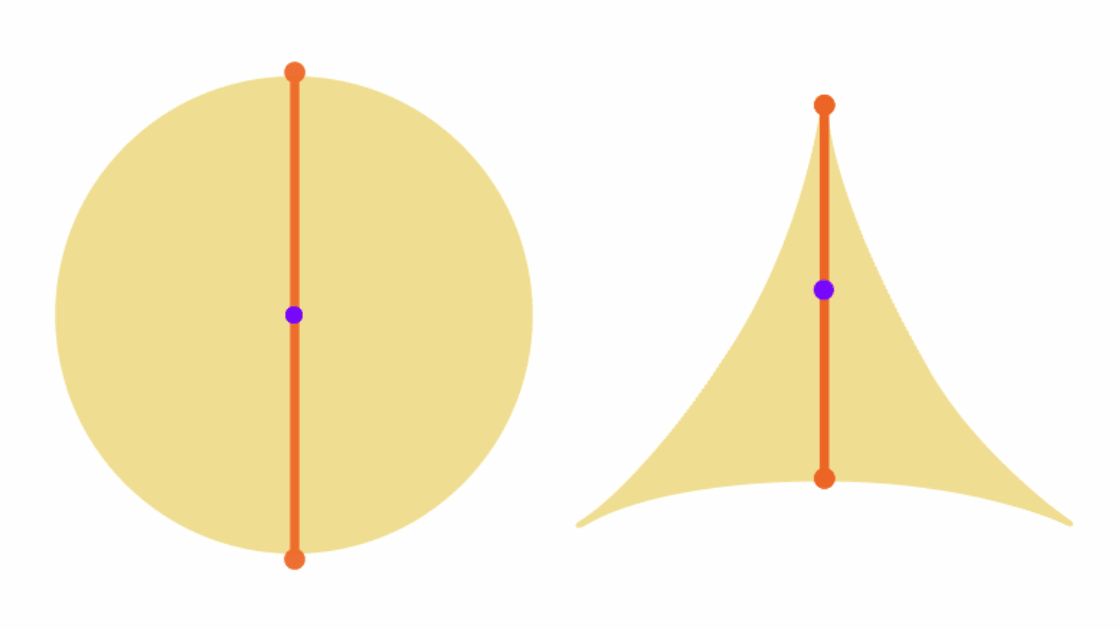New Proof Threads the Needle on a Sticky Geometry Problem

Samuel Velasco/Quanta Magazine
Introduction
In 1917, the Japanese mathematician Sōichi Kakeya posed what at first seemed like nothing more than a fun exercise in geometry. Lay an infinitely thin, inch-long needle on a flat surface, then rotate it so that it points in every direction in turn. What’s the smallest area the needle can sweep out?
If you simply spin it around its center, you’ll get a circle. But it’s possible to move the needle in inventive ways, so that you carve out a much smaller amount of space. Mathematicians have since posed a related version of this question, called the Kakeya conjecture. In their attempts to solve it, they have uncovered surprising connections to harmonic analysis, number theory and even physics.
“Somehow, this geometry of lines pointing in many different directions is ubiquitous in a large portion of mathematics,” said Jonathan Hickman of the University of Edinburgh.
But it’s also something that mathematicians still don’t fully understand. In the past few years, they’ve proved variations of the Kakeya conjecture in easier settings, but the question remains unsolved in normal, three-dimensional space. For some time, it seemed as if all progress had stalled on that version of the conjecture, even though it has numerous mathematical consequences.
Now, two mathematicians have moved the needle, so to speak. Their new proof strikes down a major obstacle that has stood for decades — rekindling hope that a solution might finally be in sight.
What’s the Small Deal?
Kakeya was interested in sets in the plane that contain a line segment of length 1 in every direction. There are many examples of such sets, the simplest being a disk with a diameter of 1. Kakeya wanted to know what the smallest such set would look like.
He proposed a triangle with slightly caved-in sides, called a deltoid, which has half the area of the disk. It turned out, however, that it’s possible to do much, much better.

The deltoid to the right is half the size of the circle, though both needles rotate through every direction.
Merrill Sherman/Quanta Magazine
In 1919, just a couple of years after Kakeya posed his problem, the Russian mathematician Abram Besicovitch showed that if you arrange your needles in a very particular way, you can construct a thorny-looking set that has an arbitrarily small area. (Due to World War I and the Russian Revolution, his result wouldn’t reach the rest of the mathematical world for a number of years.)
To see how this might work, take a triangle and split it along its base into thinner triangular pieces. Then slide those pieces around so that they overlap as much as possible but protrude in slightly different directions. By repeating the process over and over again — subdividing your triangle into thinner and thinner fragments and carefully rearranging them in space — you can make your set as small as you want. In the infinite limit, you can obtain a set that mathematically has no area but can still, paradoxically, accommodate a needle pointing in any direction.
“That’s kind of surprising and counterintuitive,” said Ruixiang Zhang of the University of California, Berkeley. “It’s a set that’s very pathological.”
This result can be generalized to higher dimensions: It’s possible to construct a set with arbitrarily small volume that contains a unit line segment pointing in every direction in n-dimensional space.
Besicovitch seemed to have solved Kakeya’s question completely. But decades later, mathematicians started to work on another version of the problem in which they replaced area (or volume, in the higher-dimensional case) with a different notion of size.
To understand this reframing of the question, first take each line segment in a Kakeya set and fatten it up a little bit — as if you were using an actual needle, rather than an idealized one. In the plane, your set will consist of extremely thin rectangles; in three-dimensional space, you will have a collection of extremely thin tubes.
These fattened sets always have some area (or volume, but we’ll stick to the two-dimensional case for now). As you change the width of your needle, this area will change. In the 1970s, the mathematician Roy Davies (who died last month) showed that if the total area changes by a small amount, the width of each needle must change drastically. For instance, if you want a fattened version of Besicovitch’s set to have an area of 1/10 of a square inch, each needle needs to have a thickness of around 0.000045 inch: e−10 of an inch, to be precise. But if you wanted to make the total area 1/100 of a square inch — 10 times smaller — the needle would have to be e−100 of an inch thick. (Forty-three zeros follow the decimal point before you get to the other digits.)
“If you tell me how small you want the area to be, then I have to demand a needle which is just unbelievably thin,” said Charles Fefferman of Princeton University.
Mathematicians measure the “size” of the Kakeya set using a quantity called the Minkowski dimension, which is related to but not quite the same as an ordinary dimension (defined as the number of independent directions you need to describe a space).
Shapes like this, taken to an extreme, can have zero area while still allowing needles in their interior to point in all directions.
Merrill Sherman/Quanta Magazine
Here’s one way to think about the Minkowski dimension: Take your set and cover it with tiny balls that each have a diameter of one-millionth of your preferred unit. If your set is a line segment of length 1, you’ll need at least 1 million balls to cover it. If your set is a square of area 1, you’ll need many, many more: a million squared, or a trillion. For a sphere of volume 1, it’s about 1 million cubed (a quintillion), and so on. The Minkowski dimension is the value of this exponent. It measures the rate at which the number of balls you need to cover your set grows as the diameter of each ball gets smaller. A line segment has dimension 1, a square has dimension 2, and a cube has dimension 3.
These dimensions are familiar. But using Minkowski’s definition, it becomes possible to construct a set that has a dimension of, say, 2.7. Though such a set doesn’t fill up three-dimensional space, it’s in some sense “bigger” than a two-dimensional surface.
When you cover a set with balls of a given diameter, you’re approximating the volume of the fattened-up version of the set. The more slowly the volume of the set decreases with the size of your needle, the more balls you need to cover it. You can therefore rewrite Davies’ result — which states that the area of a Kakeya set in the plane decreases slowly — to show that the set must have a Minkowski dimension of 2. The Kakeya conjecture generalizes this claim to higher dimensions: A Kakeya set must always have the same dimension as the space it inhabits.
That simple statement has been surprisingly difficult to prove.
A Tower of Conjectures
Until Fefferman made a startling discovery in 1971, the conjecture was viewed as a curiosity.
He was working on an entirely different problem at the time. He wanted to understand the Fourier transform, a powerful tool that allows mathematicians to study functions by writing them as sums of sine waves. Think of a musical note, which is made up of lots of overlapping frequencies. (That’s why a middle C on a piano sounds different from a middle C on a violin.) The Fourier transform allows mathematicians to calculate the constituent frequencies of a particular note. The same principle works for sounds as complicated as human speech.
Mathematicians also want to know whether they can rebuild the original function if they’re given just some of its infinitely many constituent frequencies. They have a good understanding of how to do this in one dimension. But in higher dimensions, they can make different choices about which frequencies to use and which to ignore. Fefferman proved, to his colleagues’ surprise, that you might fail to rebuild your function when relying on a particularly well-known way of choosing frequencies.
His proof hinged on constructing a function by modifying Besicovitch’s Kakeya set. This later inspired mathematicians to develop a hierarchy of conjectures about the higher-dimensional behavior of the Fourier transform. Today, the hierarchy even includes conjectures about the behavior of important partial differential equations in physics, like the Schrödinger equation. Each conjecture in the hierarchy automatically implies the one below it.
The Kakeya conjecture lies at the very base of this tower. If it is false, then so are the statements higher in the hierarchy. On the other hand, proving it true wouldn’t immediately imply the truth of the conjectures located above it, but it might provide tools and insights for attacking them.
“The amazing thing about the Kakeya conjecture is that it’s not just a fun problem; it’s a real theoretical bottleneck,” Hickman said. “We don’t understand a lot of these phenomena in partial differential equations and Fourier analysis because we don’t understand these Kakeya sets.”
Hatching a Plan
Fefferman’s proof — along with subsequently discovered connections to number theory, combinatorics and other areas — revived interest in the Kakeya problem among top mathematicians.
In 1995, Thomas Wolff proved that the Minkowski dimension of a Kakeya set in 3D space has to be at least 2.5. That lower bound turned out to be difficult to increase. Then, in 1999, the mathematicians Nets Katz, Izabella Łaba and Terence Tao managed to beat it. Their new bound: 2.500000001. Despite how small the improvement was, it overcame a massive theoretical barrier. Their paper was published in the Annals of Mathematics, the field’s most prestigious journal.
Katz and Tao later hoped to apply some of the ideas from that work to attack the 3D Kakeya conjecture in a different way. They hypothesized that any counterexample must have three particular properties, and that the coexistence of those properties must lead to a contradiction. If they could prove this, it would mean that the Kakeya conjecture was true in three dimensions.
They couldn’t go all the way, but they did make some progress. In particular, they (along with other mathematicians) showed that any counterexample must have two of the three properties. It must be “plany,” which means that whenever line segments intersect at a point, those segments also lie nearly in the same plane. It must also be “grainy,” which requires that the planes of nearby points of intersection be similarly oriented.
That left the third property. In a “sticky” set, line segments that point in nearly the same direction also have to be located close to each other in space. Katz and Tao couldn’t prove that all counterexamples must be sticky. But intuitively, a sticky set seems like the best way to force a lot of overlap among the line segments, thereby making the set as small as possible — precisely what you need to create a counterexample. If someone could show that a sticky Kakeya set had a Minkowski dimension of less than 3, it would disprove the 3D Kakeya conjecture. “It sounds like ‘sticky’ would be the most worrisome case,” said Larry Guth of the Massachusetts Institute of Technology.
It’s no longer a worry.
The Sticking Point
In 2014 — more than a decade after Katz and Tao attempted to prove the Kakeya conjecture — Tao posted an outline of their approach on his blog, giving other mathematicians the chance to try it out for themselves.
In 2021, Hong Wang, a mathematician at New York University, and Joshua Zahl of the University of British Columbia decided to pick up where Tao and Katz had left off.

Joshua Zahl and his colleague Hong Wang used a mathematical property called “stickiness” to prove that a paradoxical-sounding set cannot exist.
Paul Joseph
They started by assuming the existence of a sticky counterexample with a Minkowski dimension of less than 3. They knew from previous work that such a counterexample had to be plany and grainy. “So we were in the kind of world that Terry Tao and Nets Katz were thinking about,” Zahl said. Now they needed to show that the plany, grainy and sticky properties played off each other and led to a contradiction, which would mean that this counterexample couldn’t actually exist.
To get that contradiction, however, Wang and Zahl turned their attention in a direction that Katz and Tao hadn’t anticipated — toward an area known as projection theory.
They started out by analyzing the structure of their sticky counterexample in more detail. If you consider the idealized version of the set, it has an infinite number of line segments pointing in every direction. But in this problem, remember that you’re dealing with fattened-up versions of those line segments — a bunch of needles. Each of those needles can contain many of the idealized line segments, meaning that you can encode the entire infinite set with a finite number of needles. Depending on how thick the needles are, your fattened set might look very different.
If the set is sticky, it will look more or less the same no matter how thick the needles are.
Wang and Zahl used this property to show that as the needles get thinner, the set becomes more and more plany. Through this process, they could “extract an even more pathological object,” Zahl said — something that seemed to have impossible qualities.
That’s what they showed next. They proved that this pathological object had to look one of two ways, both of which led to contradictions. Either you’d be able to project it down into 2D space in a way that made it much smaller in many directions — something that Wang and her colleagues had just shown to be impossible. Or, in the second case, the needles in the set would be organized according to a very specific kind of function, which Zahl and his collaborators had recently proved couldn’t exist, because it would lead to other kinds of projections that didn’t make sense.
Wang and Zahl now had their contradiction — meaning that there are no sticky counterexamples to the Kakeya conjecture. (They showed this not only for the Minkowski dimension, but also for a related quantity called the Hausdorff dimension.) “The result rules out this entire class of counterexamples,” Zahl said — the exact type of set mathematicians had considered most likely to disprove the conjecture.
The new work “is strong support for the Kakeya conjecture being true,” said Pablo Shmerkin of the University of British Columbia. While it only applies to the three-dimensional case, some of its techniques might be useful in higher dimensions. After spending years making progress on the conjecture in other number systems, mathematicians are excited by this return to the problem’s original domain of real numbers.
“It’s remarkable that they solved this case completely,” Zhang said. “In the real setting, that’s extremely rare.” And if anyone can prove that a counterexample must be sticky, the new result will imply the full conjecture in three dimensions. The hierarchy of conjectures built above it will then remain safe, its foundation stable.
“Somehow, these two different problems in projection theory, which on the face of it don’t have a lot to do with each other, fit together quite nicely to give exactly what was needed for Kakeya,” Zahl said.



